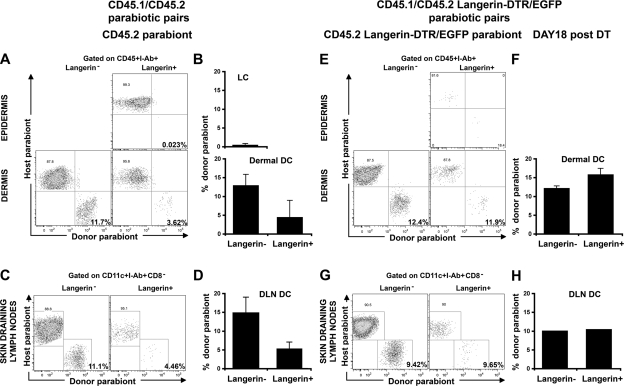Figure 3.
Homeostasis of langerin+ DCs in parabiotic mice. Each parabiotic pair consisted of one CD45.1+ C57BL/6 mouse with either a CD45.2+ C57BL/6 mouse (A–D) or CD45.2+ Langerin-DTR/EGFP C57BL/6 mouse for DT depletion experiments (E–H). (A–D) Skin and skin DLN chimerism was examined by flow cytometry in untreated CD45.2+ parabiont of a CD45.1/CD45.2 parabiotic pair at 2 mo after the initiation of parabiosis. (A) Dot plots show the chimerism of gated LCs (CD45+I-Ab+ langerin+) in the epidermis (top) and the chimerism of gated langerin− and langerin+ DCs (CD45+I-Ab+) in the dermis (bottom). (B) Bar graphs show the percentages of donor (CD45.1+)-derived cells among gated LCs (top) and langerin− or langerin+ dermal DCs (bottom). (C) Dot plots show the percentage of host and donor cells among gated CD11c+ I-Ab+ DCs, langerin−CD8− DCs and langerin+CD8− DCs. (D) Mean values of langerin− versus langerin+ DCs chimerism in CD45.2+ parabionts. Similar data are found in the skin and skin DLNs of untreated CD45.2 Langerin-DTR/EGFP parabionts (unpublished data). Representative data from 5 separate experiments are shown. Each experiment included two to four mice. Skin was separately analyzed for each mouse, whereas skin DLNs were pooled (pool of two mice); error bars represent the SD between the results obtained from each mouse (skin) or from pooled DLNs (skin DLN). (E–H) Similar data to that found in A–D was obtained from DT-treated CD45.2+ Langerin-DTR/EGFP parabiont of a CD45.1/CD45.2 Langerin-DTR/EGFP parabiotic pair. Data presented are from 18 d after DT treatment, a time when LCs are still depleted (top), whereas langerin+ dermal DCs are recovered. Representative data from two separate experiments are shown. Each experiment included two separately analyzed mice, except for the skin DLNs that were pooled. For the skin, error bars represent the SD between the results obtained from each of the two mice.

